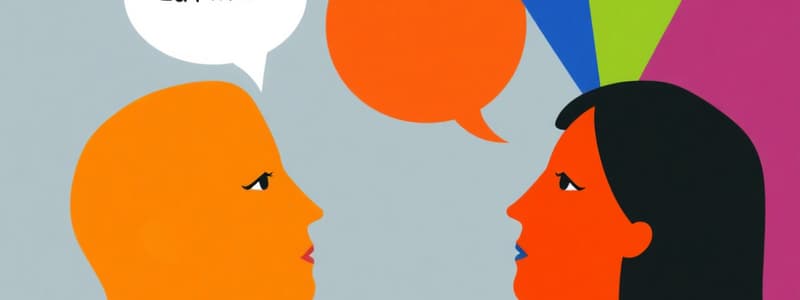Podcast
Questions and Answers
Which component of the communication process involves converting thoughts into words or gestures?
Which component of the communication process involves converting thoughts into words or gestures?
- Decoding
- Feedback
- Encoding (correct)
- Receiver
What type of communication is primarily characterized by the use of images and diagrams?
What type of communication is primarily characterized by the use of images and diagrams?
- Verbal Communication
- Written Communication
- Non-Verbal Communication
- Visual Communication (correct)
Which barrier to communication can arise from personal biases or emotional states?
Which barrier to communication can arise from personal biases or emotional states?
- Language Barriers
- Psychological Barriers (correct)
- Cultural Barriers
- Physical Barriers
Which characteristic defines assertive communication?
Which characteristic defines assertive communication?
What is essential for effective written communication?
What is essential for effective written communication?
Which communication strategy encourages open dialogue and a deeper understanding?
Which communication strategy encourages open dialogue and a deeper understanding?
What is the primary role of feedback in the communication process?
What is the primary role of feedback in the communication process?
Which of the following is NOT considered a type of communication?
Which of the following is NOT considered a type of communication?
Flashcards are hidden until you start studying
Study Notes
Definition of Communication
- Communication: The process of exchanging information, thoughts, feelings, and ideas through verbal, non-verbal, and written means.
Types of Communication
-
Verbal Communication
- Spoken language (face-to-face, phone calls, video conferencing)
- Tone of voice, pitch, and volume impact meaning
-
Non-Verbal Communication
- Body language (gestures, facial expressions, posture)
- Eye contact and proximity
- Physical appearance and dress
-
Written Communication
- Emails, letters, reports, and text messages
- Clarity and organization are essential for effective written communication
-
Visual Communication
- Use of images, diagrams, charts, and videos to convey messages
- Important for presentations and marketing materials
Importance of Communication
- Facilitates understanding and collaboration
- Builds relationships and trust
- Essential for teamwork and leadership
- Enables conflict resolution and problem-solving
Communication Process
- Sender: Initiates the message
- Encoding: Converting thoughts into words, symbols, or gestures
- Message: The information being communicated
- Channel: The medium used to transmit the message (e.g., face-to-face, email)
- Receiver: The individual or group for whom the message is intended
- Decoding: Interpreting the received message
- Feedback: Response from the receiver back to the sender
Barriers to Effective Communication
- Physical Barriers: Distance or environmental noise
- Language Barriers: Differences in language proficiency or jargon
- Psychological Barriers: Personal biases, emotions, or stress
- Cultural Barriers: Different cultural norms and values affecting interpretation
Strategies for Effective Communication
- Active listening: fully concentrate on, understand, and respond thoughtfully
- Clarity and conciseness: use simple language and avoid jargon
- Empathy: understanding and acknowledging the feelings of others
- Open-ended questions: encourage discussion and deeper understanding
- Non-verbal cues: be aware of body language and facial expressions
Communication Styles
- Assertive: Clear, confident, and respectful
- Aggressive: Forceful, often disrespectful
- Passive: Avoids conflict, may lead to misunderstanding
- Passive-Aggressive: Indirect resistance and avoidance of direct confrontation
Communication in Different Contexts
- Interpersonal Communication: Between individuals; personal and emotional
- Group Communication: Within small groups for decision-making
- Public Communication: Speaking to larger audiences (public speaking, presentations)
- Mass Communication: Through media to a large audience (television, internet)
Definition of Communication
- Communication is the exchange of information, thoughts, feelings, and ideas through verbal, non-verbal, and written means.
Types of Communication
- Verbal communication involves spoken language, either face-to-face, over the phone, or through video conferencing. Tone of voice, pitch, and volume significantly influence meaning.
- Non-verbal communication encompasses body language like gestures, facial expressions, and posture, as well as eye contact, proximity, and even physical appearance and dress.
- Written communication includes emails, letters, reports, and text messages. Clarity and organization are crucial for effective written communication.
- Visual communication utilizes images, diagrams, charts, and videos to convey messages, often proving useful in presentations and marketing materials.
Importance of Communication
- Communication facilitates understanding and collaboration, fosters relationships and trust, and is essential for teamwork and leadership.
- It also enables conflict resolution and problem-solving.
Communication Process
- Sender initiates the message.
- Encoding translates thoughts into words, symbols, or gestures.
- Message is the information being communicated.
- Channel is the medium of transmission (e.g., face-to-face, email).
- Receiver is the individual or group intended to receive the message.
- Decoding involves interpreting the received message.
- Feedback is the response from the receiver back to the sender.
Barriers to Effective Communication
- Physical barriers include distance or environmental noise.
- Language barriers arise from differences in language proficiency or jargon.
- Psychological barriers stem from personal biases, emotions, or stress.
- Cultural barriers result from different cultural norms and values affecting message interpretation.
Strategies for Effective Communication
- Active listening: fully focusing on, understanding, and responding thoughtfully.
- Clarity and conciseness: using simple language to avoid jargon.
- Empathy: understanding and acknowledging the feelings of others.
- Open-ended questions: encouraging discussion and deeper understanding.
- Non-verbal cues: being aware of body language and facial expressions.
Communication Styles
- Assertive communication is clear, confident, and respectful.
- Aggressive communication is forceful and often disrespectful.
- Passive communication avoids conflict, potentially leading to misunderstanding.
- Passive-aggressive communication involves indirect resistance and avoidance of direct confrontation.
Communication in Different Contexts
- Interpersonal communication occurs between individuals, often with personal and emotional implications.
- Group communication takes place within small groups for decision-making.
- Public communication involves speaking to larger audiences, such as in public speaking or presentations.
- Mass communication is transmitted through media to a large audience (television, internet).
Studying That Suits You
Use AI to generate personalized quizzes and flashcards to suit your learning preferences.




